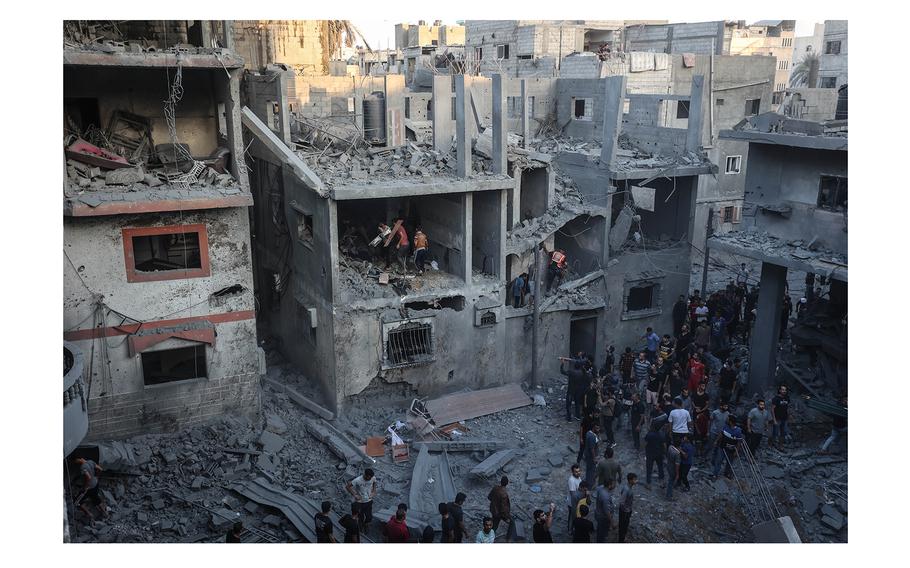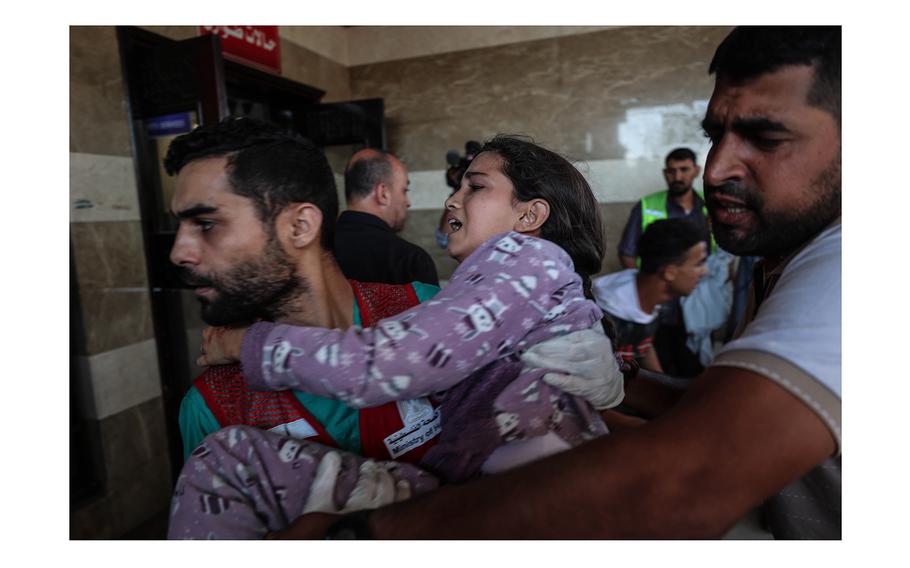Middle East
Cross-border attacks from Lebanon escalate fears of wider regional clash
The Washington Post October 20, 2023

Palestinians inspect the damage caused by an Israeli strike on a house in Khan Younis, in southern Gaza, on Thursday, Oct. 19, 2023. (Loay Ayyoub for The Washington Post)
JERUSALEM - A barrage of rockets apparently fired by militants in Lebanon struck northern Israel on Thursday, Israel’s military said, as its forces targeted the launch sites with artillery fire. The clashes further stoked fears that the Israel-Gaza war could swell into a wider regional conflict.
The cross-border attacks were among the heaviest bombardment from southern Lebanon during nearly two weeks of bloodshed in Israel and Gaza. While a Hamas branch claimed responsibility, Israel’s military said the Iranian-backed militant group Hezbollah had authorized the attack.
Adding to the sense of escalating tension in the region, U.S. forces on Thursday shot down several attack drones in Iraq and Syria, and a U.S. Navy destroyer in the Red Sea intercepted rebel-launched missiles and drones launched from Yemen, Pentagon officials said.
Brig. Gen. Patrick Ryder, the Pentagon spokesman, said it was unclear whether the drones and missiles launched in Yemen were related to the conflict but said their northward direction suggested they were heading “potentially toward targets in Israel.” Both the Houthi rebels in Yemen and militias in Syria are believed to receive weapons and support from Iran, which also supports Hamas, the Palestinian militant group that controls the Gaza Strip.
Hours earlier, Jordanian King Abdullah II and Egyptian President Abdel Fatah El-Sisi warned that the conflict “threatens to plunge the entire region into a catastrophe,” according to a readout. Other leaders, meanwhile, struggled for ways to dial down tensions.
British Prime Minister Rishi Sunak arrived in Israel facing the same dilemma as President Biden the day before: how to pledge unwavering support for Israel while also considering the plight of civilians in Gaza as Israel’s military aims to cripple Hamas in Gaza. Hamas touched off the crisis Oct. 7 with its deadly blitz into Israel.
At least 1,400 Israelis have been killed and about 200 are believed held as hostages in Gaza. Palestinian officials said more than 3,700 people have been killed and more than 12,400 injured in Gaza since the fighting began.
Sunak said at a news conference with Israeli Prime Minister Benjamin Netanyahu in Jerusalem that he was “proud to stand here with you in Israel’s darkest hour,” and he condemned what he called “unspeakable, horrific acts of terrorism” by Hamas. But echoing Biden, the British leader also urged aid for Gaza, emphasized that “the Palestinian people are victims of Hamas, too,” and added that “we mourn the loss of every innocent life.”
Sunak welcomed the deal Biden had announced, in which Israel agreed to allow limited humanitarian aid into Gaza through Egypt. Sunak expressed his hope that progress could be made on getting food, water and medicine into Gaza.
But the agreement to allow up to 20 trucks with aid through Egypt’s Rafah crossing - the only link into Gaza that Israel does not control - is contingent on no aid reaching Hamas in a territory it controls with an iron fist. Many other key questions also remained unanswered, including whether the aid will include much-needed fuel for hospital generators and when deliveries will begin.
Aid deliveries had not been expected to begin before Friday, but U.S. and United Nations officials said Thursday that a delay in road repairs to the crossing meant trucks were now unlikely to move until Saturday. The officials, speaking on the condition of anonymity about the sensitive issue, said there was a small but dwindling possibility some goods could move late Friday.
In any case, aid workers say, they will do little to save off a deepening humanitarian crisis. The U.N. has said that at least 100 trucks a day are needed to provide for more than 2 million people trapped inside Gaza without fuel or electricity, and with nearly exhausted supplies of food and water.
World Health Organization trucks “are loaded and ready to go to Gaza,” the agency’s director general, Tedros Adhanom Ghebreyesus, said.
Diplomatic efforts this week also yielded few results on allowing aid to be delivered directly from Israel to Gaza. Netanyahu continues to resist the delivery of food and medicines, saying that Hamas needs to first return Israeli hostages.

An injured girl is brought to Nasser Hospital on Thursday, Oct. 19, 2023. According to Gaza's Health Ministry, four hospitals were entirely out of service because they were directly hit in strikes. (Loay Ayyoub for The Washington Post)
The Gaza health system has been repeatedly described as on the verge of collapse. Surgeries are being conducted in the dark or canceled, said the U.N. Office for the Coordination of Humanitarian Affairs. As of Thursday, four Gaza hospitals were entirely out of service because of direct hits from Israeli bombardment, and a fifth shut down after running out of fuel, according to Gaza’s Ministry of Health.
Israel says it is targeting Hamas members in Gaza and on Thursday, a Hamas-run radio station reported the deaths of two more senior officials of the militant group. But satellite imagery shows that places of worship, hospitals, schools and homes have also been damaged or destroyed in Israeli attacks.
Israeli airstrikes have also targeted so-called safe zones in the south, including the city of Khan Younis. Israel had ordered more than 1 million people to evacuate northern Gaza ahead of an expected ground invasion.
In one attack on Thursday, an Israeli airstrike on a residential building in Khan Younis killed at least 12 people and injured at least 80 civilians, according to the Associated Press. The crater from the blast was at least one floor deep, and family members were believed to be trapped underneath the rubble, the AP reported.
The repercussions of a strike at the al-Ahli Hospital earlier this week, which deepened global anguish over civilian deaths, continued to reverberate Thursday. Palestinian authorities had blamed the strike on Israel and said it killed 471 people. The Israel Defense Forces disputed that death toll and said the strike originated inside Gaza. U.S. officials have also said Israel was not responsible, citing intelligence, aerial imagery and open-source material.
In the West Bank and the wider region, unrest continues to flare. Israeli forces killed at least six Palestinians, among them a 15-year-old, during a raid on a refugee camp in the West Bank city of Tulkarm and declared the area a closed military zone Thursday, according to the Ramallah-based Health Ministry.
At least 545 Palestinians have been displaced from Bedouin communities in the West Bank since Oct. 7, the U.N. humanitarian agency said, citing “intensified settler violence and access restrictions.” More than half of the displaced were children.
Citing “the potential for violence and increased tensions” globally, the State Department on Thursday issued a rare “Worldwide Caution Security Alert” to all Americans overseas.
It said that there was a potential for terrorist attacks, demonstrations or violent actions against U.S. citizens and interests. “Stay alert in locations frequented by tourists,” it advised.
Across Israel, security precautions remained high. Israel’s military said Hamas militants are still in the country following the Oct. 7 incursion. “Yesterday we found a terrorist, exhausted, on his way to Gaza,” IDF spokesman Daniel Hagari said Thursday, adding that the man was being interrogated.
Noack reported from Islamabad, Pakistan. Miriam Berger in Jerusalem, Karen DeYoung and Dan Lamothe in Washington, Kelly Kasulis Cho in Seoul, and Louisa Loveluck, Leo Sands, Ellen Francis and Jennifer Hassan in London contributed to this report.